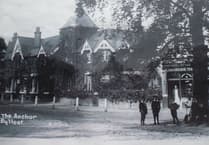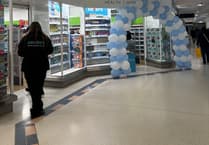There appears to have been some strange goings-on at Woking’s former Red House Hotel.
Customers brought in their ferrets, others showed off goldfinches and chaffinches they had caught in nets, while some brought herbs they had gathered to give to people who were ill.
The Red House Hotel was in Chobham Road, on the corner with Cherstey Road.
It was an earlier building to the later The Red House pub that was built in the garden of the former hotel, and which today is O’Neills, in Crown Square.
In September 1958, the News & Mail published a story with memories of a former manager of the hotel, Mr E Clark, of some 50 years previously.
He recalled the hotel “stood out in the town centre, that was surrounded by beautiful country and rural scenes, and all the residents in the vicinity were just country folk”.
As well as the ferrets, wild birds and herbs, Mr Clark’s memories also included that the premises was always well patronised by soldiers, and that a number of “Red Caps” stood on duty outside.
They were also needed inside on Saturday nights when things got out of hand as “in those good old days it did not take large quantities of beer to make soldiers fight”.
He remembered when a great circus came nearby “with wild animals” and it was the only time he saw a man put his head inside a lion’s mouth.
The owner of the hotel in Mr Clark’s time was Mr Gibbs, an ex-officer of the 14th Hussars, who also owned the Albion Hotel in Woking.
Evidently, Mr Gibbs welcomed all soldiers. Mr Clark recalled: “It was a real sight at times to see the lounge and saloon bar filled with Royal Horse Guardsmen and their splendid regimental dress.”
Guests at the hotel included “a very good artist and his wife”. And, he recalls: “The artist would pick out a lovely house with beautiful countryside and sketch it on the spot.
“Returning to the hotel he would paint the picture from the sketch. He wife would then go by horse-drawn cab from the station to the house which he had used as his subject.
“She never failed to sell the painting.”
Now we fast forward to 1974 and a story in the News & Mail about finding a new name for The Red House pub.
The story revealed brewers Ind Coope were planning to give the pub, built in the 1930s, a £20,000 facelift and wanted to give it a new name to go with its new look.
The brewery was inviting readers, especially The Red House’s regulars, to submit an apt name for the pub, with a prize of £25 for the appropriate name chosen.
It added that judging the entries would be Tim Hughes, a director of Ind Coope, Dennis Cooke, the brewery’s area manager, the pub’s manager Dennis Elder, and a customer of the pub to be nominated by Mr Elder, plus the reporter who wrote the story, but whose name was not given.
It also stated the winner would be invited to the re-opening of the pub with its new name.
However, it was added that: “If, in the opinion of the judges, no appropriate name is submitted, the brewers will make their own choice.”
It would appear nothing suitable was suggested and the pub remained The Red House!
My thanks to Mark Coxhead for finding these two newspaper articles.
Moreover, I recall in the 1980s The Red House was the watering hole of members of the editorial team of the News & Mail, who were based not far away at 52 Chertsey Road.
One of those was Fergus Cashin, who was the newspaper’s chief sub-editor, and a real maverick character.
He died in 2005, aged 81. An obituary in the Press Gazette was written by a former News & Mail reporter, James Steen.
Among his recollections were: “With his white hair, craggy face and broken nose, he reminded me of the actor Richard Harris (a former Cashin drinking partner).
“Initially, he refused to acknowledge my presence, but that changed when he came to sub one of my stories.
“As he turned the folios, I could hear him sighing and cursing.
“It was as if he was examining a hefty tax bill.
“Then he held the pages above his head and screamed at the window in front of him: ‘Who wrote this c***?’
“It was a yell that halted the clickety-clack of the newsroom typewriters.
“When he had calmed down, he taught me lesson number one: ‘Before handing in your copy, read it, re-read it and read it again.’
“That evening, he invited me for a jar at the office local, The Red House. After that, journalism became fun.
“At our table in the pub, he would recount his Fleet Street anecdotes, seeing off the risk of a dry throat by downing pints of London Pride and then doubles of Bushmills. He liked to talk about his old mate Richard Burton.
“The regulars in the pub became good sources. Ferg believed everyone has a story: ‘You just have to catch them at the right time.’
“Drinkers would be grilled for information as they stepped into the pub. They would be questioned again on their way out because, Ferg reasoned, ‘they’ve been here so long, they must have heard something’. Often, they had.”




